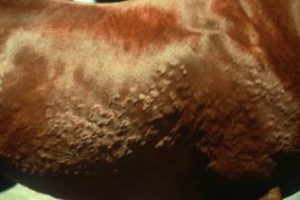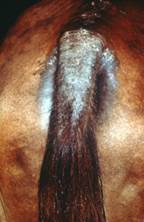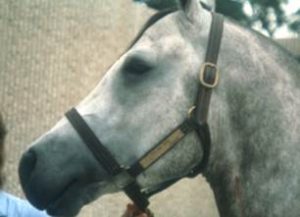2.5 Food Allergy/Intolerance – Horses
Learning Objectives
- Describe the clinical signs associated with food allergies in horses.
- List the rule-outs for tail rubbing in horses.
- List all the steps involved in performing a food elimination trial.
- Describe how to manage food allergy.
-
General Considerations
- Most reports of equine food allergy are anecdotal and limited to textbooks or review articles. The authors could not find well documented cases in the peer-reviewed literature.
- Incriminated substances reported in textbooks but not confirmed through systematic food trials are the following:
- Sweet feed, oats, corn, dry garlic, feed additive, and alfalfa.
-
Pathogenesis
- An animal can have an allergic reaction or intolerance to the above described food stuffs.
- Allergic reactions to foods are believed to be caused by multiple immunologic mechanisms, including type I (immediate, IgE mediated), type III (immune complex mediated) and, type IV (delayed, cell mediated) hypersensitivity reactions. Type I is believed to be implicated in most cases.
- Food intolerance could result from nonimmunologic mechanisms that may include metabolic, pharmacologic, or idiosyncratic.
-
Clinical Signs
- Classically, food allergy is considered a nonseasonal pruritic dermatosis. However, it may occasionally be seasonal or sporadic if the animal is consistently receiving the offending substance at a particular time of the year. Typically, only one animal is affected in the farm.
- Horses:
- Chronic or recurrent urticaria (not always pruritic in horses) and pruritus most commonly localized to the face, neck, trunk and rump. In some horses, pruritus is predominantly or exclusively localized to the tail and, in these cases, anal/perianal pruritus should be investigated as the cause.



-
-
- The differential diagnoses should include other causes of urticaria, insect bite hypersensitivity, pruritic parasitic diseases, and atopic dermatitis.
- For pruritus localized to the tail, one should also consider pinworm infestation (oxyuriasis), pediculosis (lice), chorioptic mange, insect bite hypersensitivity, atopic dermatitis, stable vice and tail pyoderma. Keep in mind that for most of these disorders, with the exception of stable vice and oxyuriasis, pruritus will also be present in other parts of the body. Make sure to always exam the perianal and anal regions in horses with pruritus localized to the tail.
-
-
Diagnosis
- History and clinical signs.
- Ruling out other possible pruritic disorders with the appropriate tests.
- The diagnosis can only be made reliably by performing a systematic elimination diet trial. The protocol described below is a slight modification of the one extensively used in dogs and cats but it has not been validated in horses.
- The animal is fed a restricted diet for a period of 4 weeks. It is important to note that this time is arbitrary as the ideal trial duration is not yet determined in horses.
- Restricted diets should be individualized for each horse based on a careful dietary history.
- Eliminate first all supplements, concentrates, additives and treats for 4 weeks. If no improvement, take off any sweet feed and/or grain and feed a bulk diet not previously used (e.g. alfalfa, or timothy hay).
- If some type of grain is necessary in addition to the bulk diet, the owner/keeper can switch from a sweet-mixed feed to a pure grain, such as oats or corn. Which grain is used will depend on the contents of the original diet.
- Again, no treats (horses mainly) or supplements should be given during this time.
- The owner/keeper should watch for a decrease in pruritus during the 4 weeks the animal is on the elimination diet.
- If improvement is observed, the owner/keeper should feed all elements of the previous ration to determine whether clinical signs will recur. If the animal is allergic to one or more ingredients present in the ration, itching should reoccur in 3 to 7 days but it may take 14 days.
- If food allergy is confirmed each element of the previous ration can be reintroduced one by one, each at every 7 to 14 days, to determine the incriminating allergen(s).
- Serologic or intradermal tests are not accurate to diagnose food allergy.
- Treatment:
- The treatment for food allergy entails removing the offending food, supplement, or additive from the diet.
- In pruritic horses, glucocorticoid therapy should be considered when a strict food trial cannot be performed.
- Antihistamines can be tried to prevent recurrence of urticarial lesions in horses that responded to a food trial but the offending diet could not be identified. Antihistamines are not effective in resolving urticarial lesions that have been already formed.
Important Facts
- Allergic reactions to foods are believed to be caused by multiple immunologic mechanisms, including type I, type III, and type IV hypersensitivity.
- Clinical signs are classically year-round but they can be seasonal if the animal is receiving the offending substance at one particular time of the year.
- In horses with tail rubbing the differential diagnosis should include insect hypersensitivity, chorioptic mange, pinworm infestation, lice and stable vice.
- Definitive diagnosis can only be made by performing a systematic elimination trial diet.
- Treatment consists of removing the offending food, supplement, or additive from the diet.
References
Fadok, V.A. Overview of Equine Pruritus. In: Veterinary Clinics of North America: Equine Practice, W.B. Saunders, Philadelphia, PA, 1995, p 1-10.
Favrot C and Olivry T. On the possible role of food allergy in chronic urticarial in racing horses. Vet Derm 2021; DOI: 10.1111/vde.12964.
Littlewood JD. Food allergy in the horse. J Equine Vet Sci 2002; 22: 129.
Marsella R, White S, Fadok VA et al. Equine allergic skin diseases: Clinical consensus guidelines of the World Association for Veterinary Dermatology. Vet Derm 2023; DOI: 10.1111/vde.13168.
Miyazawa K, Ito M, Ohsaki K. An equine case of urticaria associated with dry garlic feeding. J Vet Med Sci 1991; 53: 747–748.
Pali-Schöll I, De Lucia M, Jackson H et al. Comparing immediate type food allergy in humans and companion animals–revealing unmet needs. Allergy 2017; 1-14.
Scott, D.W.. Immunologic Diseases. In: Large Animal Dermatology. 1st ed., W.B. Saunders, Philadelphia, PA, 1988, p 301-302.

